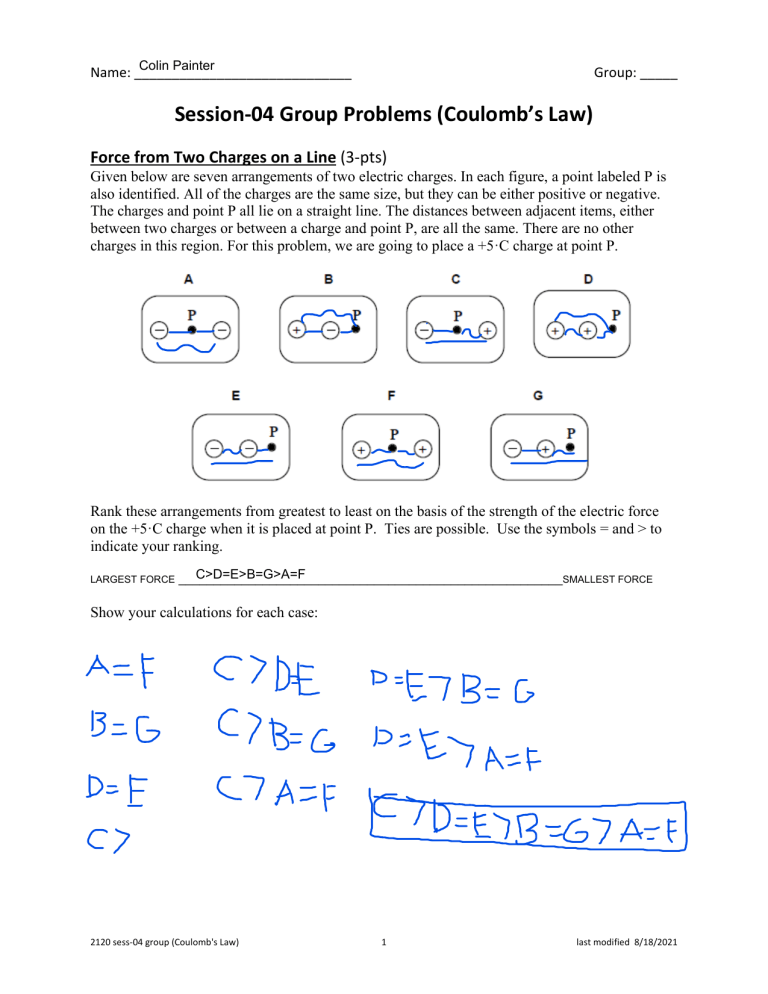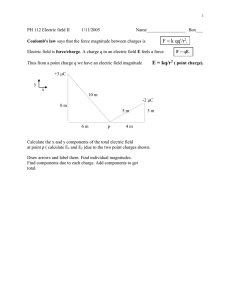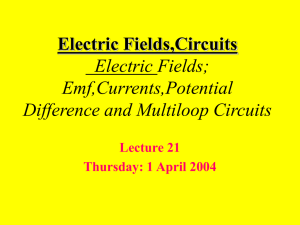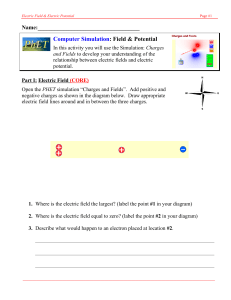
Colin Painter Name: _____________________________ Group: _____ Session-04 Group Problems (Coulomb’s Law) Force from Two Charges on a Line (3-pts) Given below are seven arrangements of two electric charges. In each figure, a point labeled P is also identified. All of the charges are the same size, but they can be either positive or negative. The charges and point P all lie on a straight line. The distances between adjacent items, either between two charges or between a charge and point P, are all the same. There are no other charges in this region. For this problem, we are going to place a +5·C charge at point P. Rank these arrangements from greatest to least on the basis of the strength of the electric force on the +5·C charge when it is placed at point P. Ties are possible. Use the symbols = and > to indicate your ranking. LARGEST FORCE C>D=E>B=G>A=F _______________________________________________________ SMALLEST FORCE Show your calculations for each case: 2120 sess-04 group (Coulomb's Law) 1 last modified 8/18/2021 Three Charges on a Line Exert Forces on Each Other (4-pts) Three charges … 𝑄1 = −100·nC, 𝑄2 = +50·nC, and 𝑄3 = −50·nC … are located near each other, as shown in the figure; the grid spacing is 1·m. Your goal is to find the net force on each of the charges. Q1 Q2 Q3 Open but DO NOT run the Interactive Physics simulation G45-1 (three charges in a line). Step 1: Find the forces exerted by Q1 and Q2 on each other; you must include a sign to indicate direction (right is positive). Write your answer in the blanks below and then check your answer by running the simulation (set 𝑄1 = −100, 𝑄2 = +50, and 𝑄3 = 0). force exerted by Q1 on Q2 = 𝐹12 =___________________ N force exerted by Q2 on Q1 = 𝐹21 =___________________ N Step 2: Find the forces exerted by Q1 and Q3 on each other; you must include a sign to indicate direction (right is positive). Write your answer in the blanks below and then check your answer by running the simulation (set 𝑄1 = −100, 𝑄2 = 0, and 𝑄3 = −50). force exerted by Q1 on Q3 = 𝐹13 =___________________ N force exerted by Q3 on Q1 = 𝐹31 =___________________ N 2120 sess-04 group (Coulomb's Law) 2 last modified 8/18/2021 Step 3: Find the forces exerted by Q2 and Q3 on each other; you must include a sign to indicate direction (right is positive). Write your answer in the blanks below and then check your answer by running the simulation (set 𝑄1 = 0, 𝑄2 = +50, and 𝑄3 = −50). force exerted by Q2 on Q3 = 𝐹23 =___________________ N force exerted by Q3 on Q2 = 𝐹32 =___________________ N Step 4: Use your results for the individual forces to find the NET FORCE on each of the charges; you must include a sign to indicate direction (right is positive). Write your answer in the blanks below and then check your answer by running the simulation (set 𝑄1 = −100, 𝑄2 = +50, and 𝑄3 = −50). net force on Q1 = (𝐹1 )𝑛𝑒𝑡 =___________________ N net force on Q2 = (𝐹2 )𝑛𝑒𝑡 =___________________ N net force on Q3 = (𝐹3 )𝑛𝑒𝑡 =___________________ N 2120 sess-04 group (Coulomb's Law) 3 last modified 8/18/2021 Force Direction on Charges in an Equilateral Triangle (2-pts) Three charges are fixed at the vertices of each equilateral triangle shown below. All charges have the same magnitude. Determine the direction of the net electric force acting on each charge due to the other two charges in the same triangle. Answer by using letters A through L representing directions from the choices below. Force Direction on Charges in a Right Triangle (2-pts) Three charges are fixed at the vertices of each right isosceles triangle shown below. All charges have the same magnitude. Determine the direction of the net electric force acting on each charge due to the other two charges in the same triangle. Answer by using letters A through H representing directions from the choices below. If the angle is between two directions, indicate both directions … such as AB for a direction between A and B. 2120 sess-04 group (Coulomb's Law) 4 last modified 8/18/2021 Force Direction on Charges in a Square (2-pts) Four charges are fixed at the vertices of each square shown below. All charges have the same magnitude. Determine the direction of the net electric force acting on each charge due to the other three charges in the same square. Answer by using letters A through H representing directions from the choices given below. If the angle is between two directions, indicate both directions … such as AB for a direction between A and B. 2120 sess-04 group (Coulomb's Law) 5 last modified 8/18/2021 Force from Two Charges in 2D (3-pts) Given below are arrangements of two fixed electric charges. In each figure, a point labeled P is also identified. All of the charges are the same size, q, but they can be either positive or negative as indicated. The distances between adjacent items, either between two charges or between a charge and point P, are all the same. There are no other charges in this region. For this problem, we are going to place a test charge, +Q, at point P. Rank these arrangements from greatest to least on the basis of the strength (magnitude) of the electric force on the test charge, +Q, at P. Ties are possible. Use the symbols = and > to indicate your ranking. A=E=F=G>B=C>D=H LARGEST FORCE ________________________________________________________SMALLEST FORCE Show your calculations for one case from each group of forces that are equal: 2120 sess-04 group (Coulomb's Law) 6 last modified 8/18/2021 Three Charges in 2D (4-pts) Three charges … 𝑄1 = +8·μC, 𝑄2 = +5·μC, and 𝑄3 = −6·μC … are located near each other, as shown in the figure; the grid spacing is 10·cm. Your goal is to find the net force on charge 𝑄3 due to the other two charges. Q1 Open but DO NOT run the Interactive Physics simulation G46-1 (three charges in 2D). Q2 Q3 Step 1: Find the magnitude of the force exerted by 𝑄1 on 𝑄3 . Write your answer in the blank below and check your answer by running the simulation. (set 𝑄1 = +8, 𝑄2 = 0, and 𝑄3 = −6) magnitude of force exerted by 𝑄1 on 𝑄3 = 𝐹13 = ___________________ N Step 2: Find the components of the force exerted by 𝑄1 on 𝑄3 ; you must include a sign for each component (up and right are positive). Check your answer with the simulation by clicking on the 𝐹𝑥 and 𝐹𝑦 buttons below |𝐹| in the force display. Once you have checked your answer, click on the component buttons again to turn them off. force exerted by 𝑄1 on 𝑄3 : (𝐹13 )𝑥 = __________________ N (𝐹13 )𝑦 = __________________ N 2120 sess-04 group (Coulomb's Law) 7 last modified 8/18/2021 Step 3: Find the magnitude of the force exerted by 𝑄2 on 𝑄3 . Write your answer in the blank below and check your answer by running the simulation. (set 𝑄1 = 0, 𝑄2 = +5, and 𝑄3 = −6) magnitude of force exerted by 𝑄2 on 𝑄3 = 𝐹23 = ___________________ N Step 4: Find the components of the forces exerted by 𝑄2 and 𝑄3 on each other; you must include a sign for each component (up and right are positive). Check your answer with the simulation by clicking on the 𝐹𝑥 and 𝐹𝑦 buttons below |𝐹| in the force display for each charge. Once you have checked your answer, click on the component buttons again to turn them off. force exerted by 𝑄2 on 𝑄3 : (𝐹23 )𝑥 = __________________ N (𝐹23 )𝑦 = __________________ N 2120 sess-04 group (Coulomb's Law) 8 last modified 8/18/2021 Step 5: Use your results to find the net force (magnitude and direction) on 𝑄3 . Write your answers in the blanks below. To check your answers: (1) make sure all three force buttons (𝐹𝑥 , 𝐹𝑦 , and |𝐹|) are on; (2) set the values of the charges to 𝑄1 = +8, 𝑄2 = +5, and 𝑄3 = −6; (3) run the simulation. You will need to ask your instructor to check the direction. net force on 𝑄3 : (𝐹3 )𝑥 = __________________ N (𝐹3 )𝑦 = __________________ N (𝐹3 )𝑛𝑒𝑡 = _________________ N 2120 sess-04 group (Coulomb's Law) 9 direction = _________ ° last modified 8/18/2021





